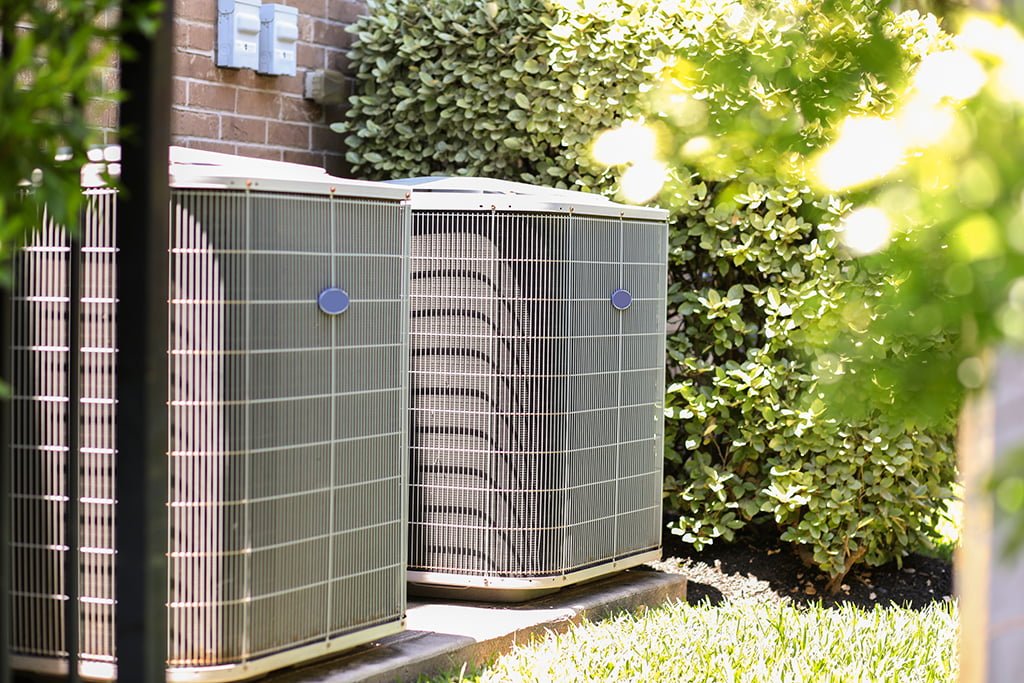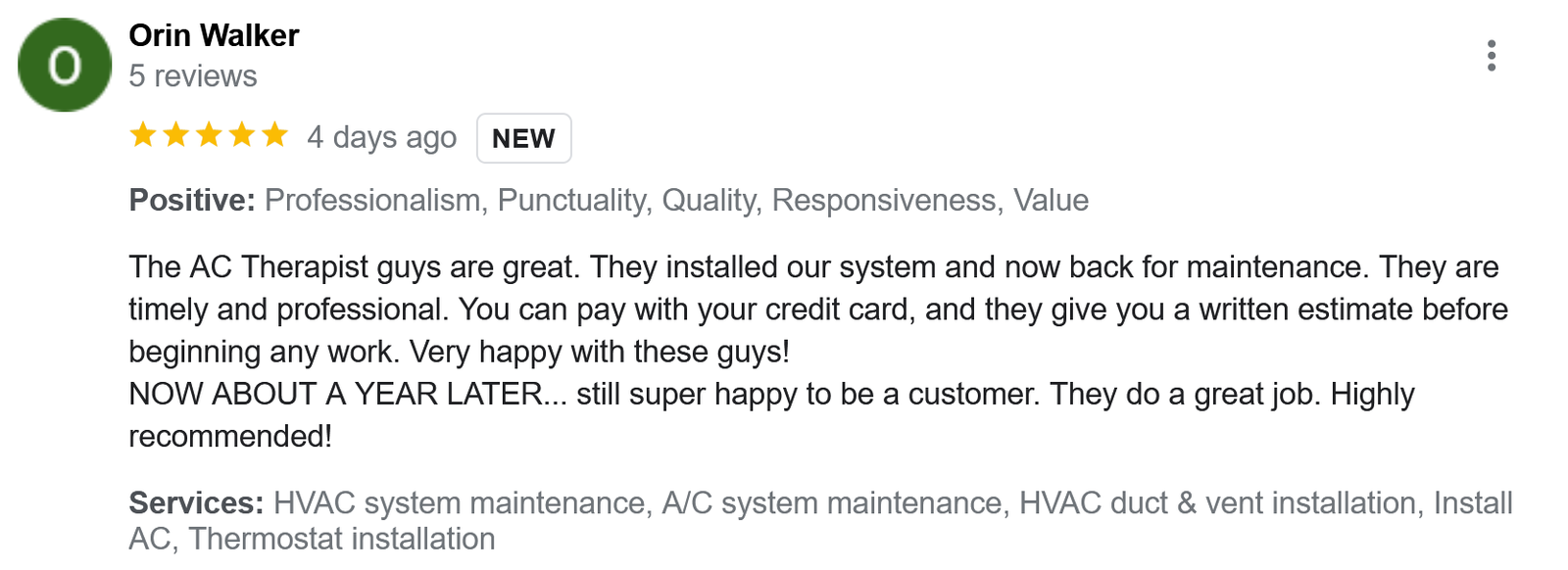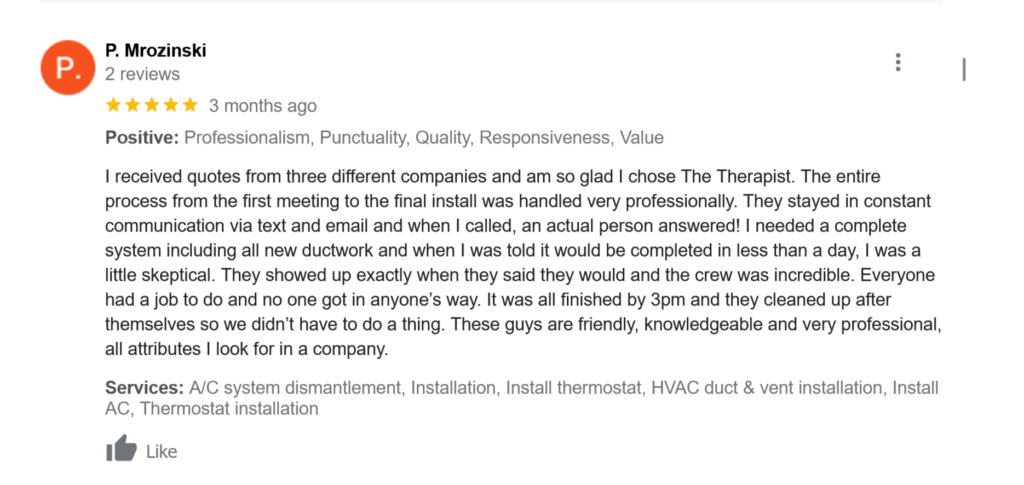Heating Installation
Stay comfortable during chilly Tampa Bay winters with expert heating installation from The AC Therapist. We offer seamless installation of a range of heating systems, ensuring optimal warmth and efficiency. Our experienced team carefully assesses your needs to provide the perfect heating solution. Trust us for reliable, efficient, and long-lasting heating installations.

Heating Installation in Tampa Bay
Your Trusted Partner for Comprehensive Heating Installation in Tampa Bay
At The AC Therapist, we specialize in providing top-notch heating installations that keep Tampa Bay homes comfortably warm all winter long. Our comprehensive installation process and dedicated team set us apart from the rest.
Our Process
Assessment: We begin by assessing your home’s specific heating needs, considering factors like size, layout, insulation, and your personal comfort preferences.
Recommendation: Based on our assessment, we recommend the most suitable heating system for your home. We offer a range of high-quality systems, including heat pumps and gas furnaces.
Installation: Our skilled technicians ensure a seamless installation, taking care to minimize disruption to your home. We adhere to all safety regulations and industry standards, ensuring your system is installed correctly and efficiently.
Testing: Post-installation, we conduct rigorous testing to ensure the system is operating at peak performance. We make any necessary adjustments for optimal functionality and comfort.
Training: We provide you with a walkthrough of your new heating system’s operations and maintenance needs, empowering you to use and maintain it effectively.
Why Choose The AC Therapist?
Experience & Expertise: Our team of certified technicians possesses the skill and knowledge to handle all types of heating installations. We’re experienced in installing a wide range of systems and brands.
Quality Customer Service: Your comfort is our priority. We pride ourselves on providing excellent customer service and making the installation process smooth and stress-free.
Transparency & Trust: We offer upfront pricing with no hidden fees. Our team is committed to providing honest advice and recommendations tailored to your needs.
Post-Installation Support: Our commitment to your comfort extends beyond the installation. We offer ongoing maintenance and support to ensure your heating system continues to operate at its best.
Choose The AC Therapist for your heating installation needs in Tampa Bay. Experience efficient, reliable warmth, exceptional customer service, and the peace of mind that comes with choosing a trusted HVAC provider.


Why Choose The AC Therapist?
The AC Therapist is not only committed to providing the best Heating Installation services, but also providing the right education to homeowners on how to best handle their HVAC units so that small problems do not become larger and more costly issues down the line.
We proudly serve those in the Hillsborough, Pasco, and Pinellas County for over ten years. If you would like more information, feel free to give them a call at (813)-343-2212 or you can book online and get their latest discount!
No Hidden or Unexpected Charges
Free Estimates & Online Booking Available
Professionally Trained Technicians
Honesty is Guaranteed
Quick Communication & Service Within 24 Hours
400+ 5 Star Reviews
Your questions answered
Common Heating Installation Questions:
How much does installing a heating system cost?
The cost to install a heating system can vary greatly depending on several factors, including:
Type of Heating System: The cost can significantly differ based on whether you’re installing a heat pump, a gas furnace, an oil furnace, or an electric heating system.
Size of the System: Larger systems that can produce more heat typically cost more than smaller ones. The right size for your home depends on factors like the size of your home, its insulation, and the local climate.
Brand: The cost can vary depending on the brand of the heating system. Higher-end brands tend to cost more, but they may also offer superior performance or durability.
Complexity of Installation: If the installation involves additional work such as ductwork modification or electrical upgrades, the cost will be higher.
Local Labor Rates: Labor costs can vary depending on where you live. In areas with higher costs of living, you can expect to pay more for installation.
Given these variables, it’s difficult to provide a specific price without more information. A ballpark range could be anywhere from $5,500 to $9,500 for a typical residential heating system installation, but this can be significantly higher for complex installations or high-end systems. For a precise quote, you should contact a local HVAC professional like The AC Therapist.
Remember, while the upfront cost can be substantial, a properly installed, efficient heating system can provide comfort for years and potentially save you money on your energy bills in the long run. The AC Therapist offers transparent pricing and high-quality installation services to provide the best value for your investment.
What is the best heating to install?
The “best” heating system to install can greatly depend on various factors, including your local climate, the size and insulation of your home, your budget, and your personal preferences. However, here’s a comparison between the three systems you mentioned: heat pump, furnace, and electric heat strip on a straight cool system:
Heat Pumps: These systems are highly efficient and provide both heating and cooling. They work by transferring heat from one area to another. In the winter, they extract heat from outside and move it into your home. In the summer, they do the reverse, moving heat from inside your home to the outside. This makes them an excellent choice for moderate climates. However, their efficiency can drop in extremely cold conditions.
Gas Furnaces: These are a traditional and widely used option, particularly in colder climates. They generate heat by burning fuel (typically natural gas, propane, or oil). Furnaces are capable of producing higher levels of heat than heat pumps and can operate efficiently in very cold conditions. However, they require a separate cooling system for the summer months and can be more expensive to run if fuel prices are high.
Electric Heat Strips on Straight Cool Systems: Straight cool systems are air conditioning units that are paired with an electric heat strip for heating. They can be a cost-effective solution in mild climates where heating is only occasionally needed. However, electric heat strips consume a significant amount of electricity, making them a more expensive option in terms of energy use, especially in colder climates where more heating is required.
In summary, the best system to install largely depends on your specific circumstances. In the mild but occasionally cool climate of Tampa Bay, a heat pump may be the most efficient and versatile choice for many homeowners. However, if the home already has a straight cool system, an electric heat strip might be a cost-effective way to add some heating capacity. If the winters are particularly cold or the homeowner prefers a separate system for heating, a gas furnace might be a better fit.
The AC Therapist team can provide a professional assessment of your home and help you determine the most suitable system for your specific needs, considering factors such as energy efficiency, installation cost, operational cost, and local climate.
How do you install a heating system in a house?
Installing a heating system in a house involves several steps and should always be conducted by a certified professional HVAC technician to ensure safety and efficiency. Here’s a general overview of the process:
Assessment: The first step is to assess the home to determine the heating needs. This includes considering factors like the size of the home, the number of rooms, insulation levels, and the local climate. This information is used to choose the most appropriate heating system.
System Selection: Based on the assessment, a suitable heating system is chosen. This could be a heat pump, a furnace, or an electric heating system, among others. The system should be the right size for the home – a system that’s too large or too small can be inefficient and lead to comfort problems.
Removal of Old System (if applicable): If there’s an existing heating system, it will need to be properly removed and disposed of.
Installation: The new heating system is installed in the location determined during the assessment. This may involve setting up the main unit, connecting it to the home’s electrical system or gas line, and installing ductwork or piping to distribute the heat. It also involves installing the thermostat and connecting it to the system.
Testing: Once the installation is complete, the system is thoroughly tested to ensure it’s operating correctly and efficiently. The technician will check things like the system’s running temperature and whether it’s effectively heating all parts of the home.
Final Walkthrough: The technician will explain the operation and maintenance of the system to the homeowner. This includes how to adjust the thermostat, when and how to change the system’s filters, and what signs might indicate a need for professional maintenance or repair.
Please remember that while this process may sound straightforward, it involves specialized knowledge and skills, as well as potential safety risks, especially when dealing with gas furnaces or electrical systems. It’s always recommended to hire a professional like The AC Therapist for such tasks to ensure the job is done safely and correctly.
How long does it take to install a heating system in a house?
The time it takes to install a heating system can vary widely based on a number of factors including:
Type of Heating System: Some systems, like heat pumps and forced air systems, can be installed within a day if no major modifications are needed. More complex systems, like geothermal or radiant floor heating, can take several days to install.
Size of the Home: A larger home will generally take longer to install a heating system in than a smaller one, as there may be more equipment to install and more ductwork or piping to set up.
Condition of Existing Infrastructure: If your home already has ductwork or piping that is in good condition and compatible with the new system, the installation time can be reduced. However, if ductwork or piping needs to be installed or replaced, this can significantly increase the installation time.
Complexity of the Installation: If the installation involves additional work such as installing a new gas line, modifying electrical wiring, or making structural changes to the home, this will increase the time needed to complete the installation.
On average, for a typical home, you might expect the installation of a new heating system to take anywhere from a 4 hours for a simple replacement to a whole day for a new installation with additional complexity. However, this is just a rough estimate and the actual time can vary. It’s always best to consult with your HVAC professional, like The AC Therapist, for a more accurate estimate based on your specific situation.
Signs Your Heating System Needs Replacement
Here are some signs that may indicate your heater needs replacement:
Age: The average lifespan of a heating system ranges from 15-20 years for furnaces and 10-15 years for heat pumps. If your heater is close to or has exceeded this age range, it may be time to consider a replacement.
Increasing Energy Bills: If you notice a significant increase in your energy bills without a corresponding increase in usage, your heating system may be losing efficiency due to age or wear and tear, indicating that a replacement may be necessary.
Frequent Repairs: If your heater requires frequent repairs, it may be more cost-effective in the long run to replace the system rather than continuing to pay for repairs.
Inconsistent Heating: If some rooms in your house are too hot while others are too cold, your heating system may not be functioning properly.
Excessive Noise: If your heating system starts making unusual noises, like banging, rattling, or humming, it might indicate a serious issue that could warrant a replacement.
Poor Indoor Air Quality: Old and malfunctioning heating systems can cause a rise in dust and allergen levels in your home, leading to poor indoor air quality.
Visible Signs of Rust or Corrosion: If there are visible signs of rust or corrosion on your heating system, especially around the furnace or heat exchanger, it’s a clear sign that you should consider a replacement.
If you notice any of these signs with your current heating system, it would be wise to consult with a heating professional, like The AC Therapist, to evaluate whether a repair or replacement is the best course of action.
Can I install my own heating system?
While technically it is possible for a homeowner to install their own heating system, it is not typically recommended unless you have substantial experience and training in HVAC systems. Here’s why:
Safety: Heating systems can involve intricate electrical wiring or dealing with combustible materials like natural gas. Incorrect installation can lead to serious safety hazards such as fires, gas leaks, or carbon monoxide poisoning.
Efficiency and Performance: Improperly installed heating systems often operate inefficiently, leading to increased energy costs and subpar heating performance. They can also lead to uneven heating, where some rooms get warmer than others.
Warranty and Regulations: Many manufacturers’ warranties are void if the heating system is not installed by a certified professional. In addition, there are local building codes and regulations to follow, and failing to do so can result in fines or difficulties when you try to sell your home.
Durability: Improper installation can lead to a shorter lifespan of the heating system, meaning you’ll have to replace it sooner.
Cost: If the system is improperly installed, you might end up paying more for a professional to correct the mistakes than you would have paid for a professional installation in the first place.
For all these reasons, we strongly recommend hiring a professional HVAC service provider like The AC Therapist. Our team has the training and expertise to ensure your new heating system is installed safely, correctly, and in compliance with all local regulations.
Furnace vs Heat Pump vs Straight cool, which is best to install?
Choosing between a furnace, heat pump, and straight cool system depends on several factors including your local climate, energy costs, home insulation, and your heating and cooling needs. Here’s a brief comparison:
Furnace: Furnaces, particularly gas furnaces, can produce a lot of heat and can be ideal for colder climates where the temperature frequently drops below freezing. They are reliable and have a relatively long lifespan. However, they don’t provide cooling, so you’d need a separate air conditioner for the summer months.
Heat Pump: Heat pumps provide both heating and cooling, making them a versatile solution. They are especially efficient in milder climates where temperatures don’t drop significantly below freezing. However, their heating efficiency can drop in very cold conditions, and they might require an auxiliary heating source for such times.
Straight Cool System: Straight cool systems are essentially air conditioning units that provide cooling only. They are suitable for hot climates where heating isn’t often needed. For winter heating, a straight cool system would need to be paired with an additional heating source, like a furnace or electric heat strips. Electric heat strips can be costly to run due to the high energy consumption, but they can provide a cost-effective solution for heating in mild climates where heating is occasionally needed.
In Tampa Bay’s relatively mild but occasionally cool climate, a heat pump might be the most efficient and versatile choice for many homeowners due to its ability to both heat and cool. A straight cool system with auxiliary heating could also work well if the home rarely needs heating. A furnace might be a suitable choice for those who prefer a separate system for heating, or for homes that need more heating than a heat pump can efficiently provide.
Always consult with an HVAC professional, like The AC Therapist, to help determine the most appropriate system for your specific circumstances. The best system for you will depend on your individual home, local energy costs, and personal comfort preferences.
How does The AC Therapist prepare for a heating installation day?
The AC Therapist prides itself on meticulous preparation and planning to ensure that the heating installation day runs smoothly. Here is our detailed approach:
Pre-installation Survey: Our process starts with a thorough in-home survey to understand the specific heating needs of your home. We consider factors such as your home’s size, insulation levels, the number of rooms, and your local climate. This allows us to recommend the most appropriate and efficient heating system for your needs.
System Selection: Based on the pre-installation survey, we help you choose the most suitable heating system. Whether it’s a heat pump, furnace, or a straight cool system with auxiliary heating, we explain the pros and cons of each option and help you make an informed decision.
Detailed Planning: Once the heating system is selected, we plan the installation process in detail. This includes scheduling the installation at a time that is convenient for you, arranging for any necessary permits, and ensuring that we have all the necessary tools and equipment.
Team Briefing: Our team of certified technicians is briefed thoroughly on the installation plan. This ensures that everyone knows their specific roles and responsibilities and can work efficiently on the day of the installation.
System Procurement: We take responsibility for procuring the heating system and any necessary components. All equipment is checked and prepared for installation.
Safety Protocols: We make sure that all safety protocols are in place. This includes protective clothing and equipment for our technicians and measures to protect your home and minimize disruption.
By the time the heating installation day arrives, The AC Therapist team is fully prepared to complete the job safely, efficiently, and to the highest professional standards. Your comfort is our priority, and we aim to make the installation process as smooth and stress-free as possible for you.

Customer Testimonials: Real Experiences with The AC Therapist
We proudly share the experiences and stories of our valued clients. Their feedback provides a glimpse into the quality of service and commitment to excellence we uphold at The AC Therapist. You'll read firsthand how our HVAC solutions have improved comfort and energy efficiency in homes across Tampa Bay. These testimonials illustrate our dedication to customer satisfaction and the difference our expert services can make.




